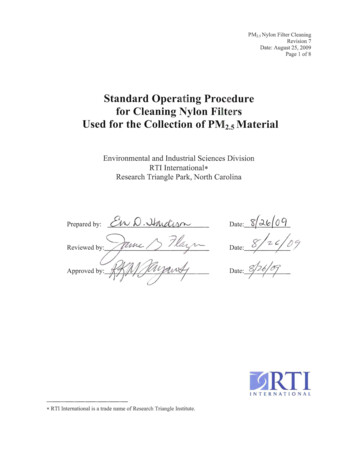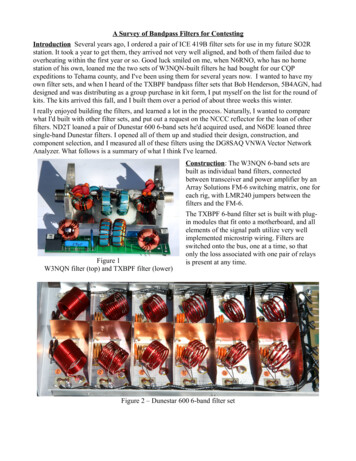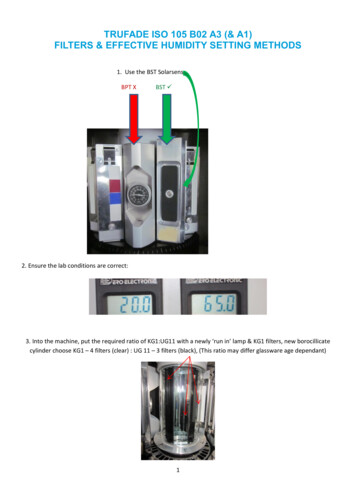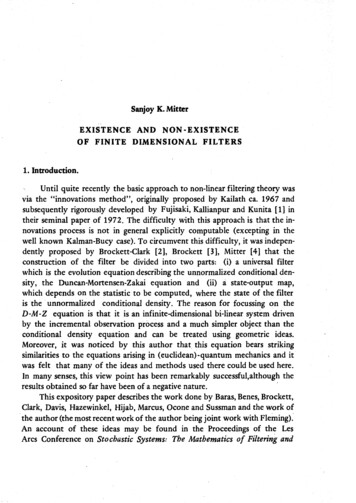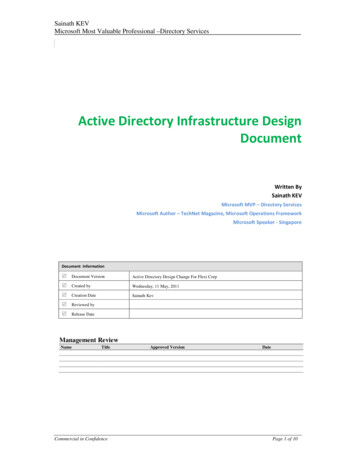
Transcription
ECE 445 Biomedical Instrumentationrev 2012Lab 8: Active Filters for Instrumentation AmplifierINTRODUCTION:In Lab 6, a simple instrumentation amplifier was implemented and tested. Lab 7 expanded upon theinstrumentation amplifier by improving circuit performance and by building a LabVIEW user interface.This lab will complete the design of your biomedical instrument by introducing a filter into the circuit.REQUIRED PARTS AND MATERIALS:Materials Needed1) Instrumentation amplifier from Lab 72) Results from Prelab3) Oscilloscope4) Function Generator5) DC Power Supply6) Labivew Software7) Data Acquisition Board8) Resistors9) Capacitors10) Dual operational amplifier (UA747)PRELAB:1. Print the Prelab and Lab8 Grading Sheets. Answer all of the questions in the Prelab GradingSheet and bring the Lab8 Grading Sheet with you when you come to lab. The Prelab GradingSheet must be turned in to the TA before beginning your lab assignment.2. Read the LABORATORY PROCEDURE before coming to lab. Note: you are not required toprint the lab procedure; you can view it on the PC at your lab bench.3. For further reading consult class notes, text book and seeLow Pass Filters http://www.electronics-tutorials.ws/filter/filter 2.htmlHigh Pass Filters http://www.electronics-tutorials.ws/filter/filter 3.htmlBACKGROUND:Active FiltersAs their name implies, Active Filters contain active components such as operational amplifiers ortransistors within their design. They draw their power from an external power source and use it to boostor amplify the output signal. Operational amplifiers can also be used to shape or alter the frequencyresponse of the circuit by producing a more selective output response by making the output bandwidthof the filter more narrow or even wider.Active filters generally use Operational Amplifiers within their design. An Op-amp has a high Inputimpedance, a Low Output impedance and a Voltage Gain resulting from the resistor combination withinits feedback loop. Active filters produce good performance characteristics, very good accuracy with asteep roll-off and low noise when used with careful circuit design.Active Low Pass Filter.This 1st-Order low pass type filter, consists simply of a passive RC filter connected to the input of aninverting operational amplifier. The frequency response of the circuit will be the same as that of thepassive RC filter, except that the amplitude of the output signal is increased by the passband voltageLab 8, Page 1
ECE 445 Biomedical Instrumentationrev 2012gain of the amplifier. For a low pass filter, the passband starts from 0Hz or DC and continues up to thespecified cut-off point at -3dB. Signals beyond the cut off frequency are attenuated. R2R1A Gain of filter F frequency of input signal in HertzFL cut off frequency in Hertz fc 12πR2CExampleDesign a Low Pass filter circuit that has a gain of 10 at low frequencies and a corner frequency of159Hz. Solve for C using the equation for the cutoff frequency. The result is a R1 10k, R2 100k,and C 10nF. The following diagram is the simplest form of an inverting low pass filter.Use the following formula to evaluate the gain of the filter in decibels whereGain 20log(A)Active High Pass FiltersA 1st-Order (single-pole) Active High Pass Filter as its name implies, attenuates low frequencies andpasses high frequency signals. It consists simply of a passive filter section followed by an invertingoperational amplifier. The passband starts from the -3dB cut-off frequency and continues up to infinityor the maximum open loop gain for an active filter.A Gain of filter R2R1F frequency of input signal in HertzLab 8, Page 2
ECE 445 Biomedical InstrumentationFH cut off frequency in Hertz fc rev 201212πR1CActive Band Pass FilterFor a low pass filter, the passband starts from 0Hz or DC and continues up to the specified cut-off pointat -3dB. Equally, for a high pass filter the passband starts from the -3dB cut-off frequency andcontinues up to infinity or the maximum open loop gain for an active filter.However, the Active Band Pass Filter is slightly different in that it will only pass frequencies or signalswithin a certain "Band" or range of frequencies that are set between two cut-off or corner points labeled"lower frequency" (ƒL) and "higher frequency" (ƒH) while attenuating any signals outside of these twopoints.A simple Active Band Pass Filter can be easily made by cascading together a single Low Pass Filterwith a single High Pass Filter. This will be the chosen method for this lab exercise. The cut-off orcorner frequency of the low pass filter (LPF) is higher than the cut-off frequency of the high pass filter(HPF) and the difference between the frequencies at the -3dB point will determine the "Bandwidth" ofthe filter while attenuating any signals outside of these points. The Bandwidth of the circuit is thedifference between the upper and lower -3dB points. For example, if the -3dB cut-off points are at200Hz and 600Hz then the bandwidth of the filter would be given as: Bandwidth (BW) 600 - 200 400Hz.Lab 8, Page 3
ECE 445 Biomedical Instrumentationrev 2012Resonant FrequencyThe actual shape of the frequency response curve for a band pass filter will depend upon thecharacteristics of the filter circuit with the curve above being defined as an "ideal" band pass response.An active band pass filter is a 2nd Order type filter because it has "two" reactive components (twocapacitors) within its circuit design and will have a peak response or Resonant Frequency (ƒr) at its"centre frequency", ƒc. The centre frequency is generally calculated as being the geometric mean ofthe two -3dB frequencies between the upper and the lower cut-off points with the resonant frequency(point of oscillation) being given as:FR FL xFHWhere FR is the resonant frequency, FL is low cut off frequency, and FH is the high cut off frequency.The example given results in FR 200x600 346HzThe "Q" or Quality FactorIn a Band Pass Filter circuit, the overall width of the actual passband between the upper and lower 3dB corner points of the filter determines the Quality Factor or Q-point of the circuit. This Q Factor isa measure of how "Selective" or "Un-selective" the band pass filter is towards a given spread offrequencies. The lower the value of the Q factor the wider is the bandwidth of the filter andconsequently the higher the Q factor the narrower and more "selective" is the filter. The Q factor iscalculated from the resonant frequency and bandwidth of the filter.Q FrBWThen for our simple example above the quality factor "Q" of the band pass filter is given as:346Hz / 400Hz 0.865.Lab 8, Page 4
ECE 445 Biomedical Instrumentationrev 2012As the quality factor of a band pass filter (Second-order System) relates to the "sharpness" of the filtersresponse around its centre resonant frequency (ƒr) it can also be thought of as the Damping Factor orDamping Coefficient because the more damping the filter has the flatter is its response and likewise,the less damping the filter has the sharper is its response. The damping ratio is given the Greek symbolof Xi, (ξ) where:ξ 2QLABORATORY PROCEDURE:Exercise 1Low Pass Filter1. Using the UA747 dual opamp, construct on your breadboard a low pass filter using the resistorand capacitor values calculated and simulated in the prelab. You may have to adjustcomponent values based on the values that are available in real resistors and capacitors.Double-check your gain and cutoff frequency calculations for the new R and C values. Connectthe power pins of the UA747 chip to the circuit breadboard power supply rails.2. Ask the TA to check your breadboard design before moving on to testing.3. Setup a DC power supply to provide 0 to 10V supply to your circuit breadboard. For analogground, use the agnd output of the instrumentation amplifier.4. Setup the function generator to produce a sin wave with an amplitude of 1 volt peak to peak anda frequency within your designed passband, say 50Hz.5. Connect the positive function generator output to the input of your low pass filter and to oneinput on the oscilloscope. Connect the negative terminal of function generator to analog ground(5V). Do not connect the negative terminal of the function generator to the oscilloscope; thescope’s negative terminal is at 0V (earth ground).6. Connect the output of your low pass filter to the oscilloscope. Double check all connections.7. Press auto set on the oscilloscope and observe if the signal output signal is amplified accordingto your gain specifications. On the grading sheet, record the output peak to peak, the calculatedgain you have achieved, and the tested input frequency.8. Calculate and record the output voltage that would represent -3dB drop in gain (drop to ½ of theoutput voltage). Start slowly increasing the frequency of the function generator until the outputamplitude falls to the -3dB point. Record the measured -3dB frequency.9. Continue increasing the frequency until the filter reaches unity gain, where the output amplitudeshould match the input signal amplitude. Record this frequency as the unity gain bandwidth.High Pass Filter10. Without disconnecting your low pass filter, use the second opamp on the UA747 to repeat steps1-9 for the high pass filter. The only difference is, in steps 8 and 9 you will have to decreasefrequency of the function generator to find the high pass cutoff frequency.Band Pass Filter11. Constructed the bandpass filter by cascading the low pass filter output into the input of the highpass filter. Quickly test the cascaded filter is working correctly by inputting a 1V sine wave andvarying the frequency to record the passband gain, low pass (upper) cutoff frequency, and highpass (lower) cutoff frequency. Use the values to calculate the bandwidth, Q factor, and dampingfactor. Ask the TA to check off exercise 1 before proceeding.Lab 8, Page 5
ECE 445 Biomedical Instrumentationrev 2012Exercise 2LabVIEW Setup1. Attach the output of the Lab 6 instrumentation amplifier to the input of your cascaded bandpassfilter and to Ai1 of the Elvis Board.2. Connect the output of the bandpass filter to Ai0 of the Elvis Board. Connect the ground of theamplifier/filter circuit breadboard to Aground of the Elvis Board.3. Open LabVIEW and open a new blank project. Insert a DAQ vi on the block diagram andconfigure it to evaluate signals with a sampling frequency of 5,000 Hz.4. On the Control screen, place 2 graphs. Split the signal coming from the DAQ vi with a signalsplitter vi and place a graph on each of these signals. One graph should display the signal fromthe instrumentation amplifier and the other should display the output of the bandpass filter.5. Place a while loop around all the vi’s on the block diagram. Run your LabVIEW setup to confirmoperation.6. Setup the function generator to create a simulated ECG signal of 30-40mV and 10Hz.7. Connect the function generator to the instrumentation amplifier by connecting the positive leadto v2 on your amplifier and the negative lead to v1. Also, connect v1 to agnd so the amplifierand function generator have the correct DC reference.8. Turn on the DC power supply to the breadboard and press run on the LabVIEW vi.9. Show the TA the following output graphs and ask him to check off exercise 2, step 9. Output of instrumentation amplifier (amplified version of ECG input) Output of bandpass filter (filtered version of amplified ECG input)ECG Signal Acquisition10. Remove the ECG electrode connectors from the isolation amplifier.11. Select a student on your team to be the patient. Attach the ECG electrode patches to the patient(see Lab 4 if you need instructions). It is recommended you attach electrodes to your chestinstead of your wrists to get good ECG signals. Connect the positive electrode to instrumentamp input v2 and the negative electrode to v1. Connect the gnd electrode connects to agnd ofyour instrumentation amplifier. Show the output graphs as described in step 27.12. Run your LabVIEW vi and observe the following output graphs. You have now replaced anexpensive commercial bioamplifier with a simple circuit and LabVIEW interface that you builtyourself in Labs 6-8! Give your partner a pat on the back. Show your plots to the TA and askhim to check off exercise 2, step 12. Output of instrumentation amplifier (amplified version of ECG input) Output of bandpass filter (filtered version of amplified ECG input)Wrap Up1. Once the TA has checked off your circuit, clean up your lab bench and return everything to itsproper place.2. Return your breadboards to the TA3. Turn in your Grading Sheet to the TA.Lab 8, Page 6
Lab 8, Page 1 Lab 8: Active Filters for Instrumentation Amplifier . INTRODUCTION: In Lab 6, a simple instrumentation amplifier was implemented and tested. Lab 7 expanded upon the instrumentation amplifier by improving circuit performance and by building a LabVIEW user interface. This lab will complete the design of your biomedical instrument by introducing a filter into the circuit. REQUIRED .

